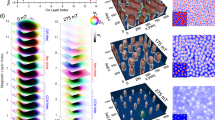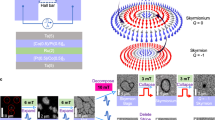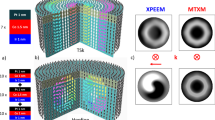Abstract
Magnetic skyrmions are chiral quasiparticles that show promise for the transportation and storage of information. On a fundamental level, skyrmions are model systems for topologically protected spin textures and can be considered as the counterpart of topologically protected electronic states, emphasizing the role of topology in the classification of complex states of condensed matter. Recent impressive demonstrations of the control of individual nanometre-scale skyrmions — including their creation, detection, manipulation and deletion — have raised expectations for their use in future spintronic devices, including magnetic memories and logic gates. From a materials perspective, it is remarkable that skyrmions can be stabilized in ultrathin transition metal films, such as iron — one of the most abundant elements on earth — if in contact with materials that exhibit high spin–orbit coupling. At present, research in this field is focused on the development of transition-metal-based magnetic multilayer structures that support skyrmionic states at room temperature and allow for the precise control of skyrmions by spin-polarized currents and external fields.
This is a preview of subscription content, access via your institution
Access options
Subscribe to this journal
Receive 12 digital issues and online access to articles
$119.00 per year
only $9.92 per issue
Buy this article
- Purchase on Springer Link
- Instant access to full article PDF
Prices may be subject to local taxes which are calculated during checkout







Similar content being viewed by others
References
Bogdanov, N. & Yablonskii, D. A. Thermodynamically stable “vortices” in magnetically ordered crystals: the mixed state of magnets. Sov. Phys. JETP 68, 101–103 (1989).
Bogdanov, N. & Hubert, A. Thermodynamically stable magnetic vortex states in magnetic crystals. J. Magn. Magn. Mater. 138, 255–269 (1994).
Rößler, U. K., Bogdanov, N. & Pfleiderer, C. Spontaneous skyrmion ground states in magnetic metals. Nature 442, 797–801 (2006).
Mühlbauer, S. et al. Skyrmion lattice in a chiral magnet. Science 323, 915–919 (2009).
Yu, X. Z. et al. Real space observation of a two-dimensional skyrmion crystal. Nature 465, 901–904 (2010).
Yu, X. Z. et al. Near room-temperature formation of a skyrmion crystal in thin-films of the helimagnet FeGe. Nat. Mater. 10, 106–109 (2011).
Yu, X. Z. et al. Skyrmion flow near room-temperature in an ultralow current density. Nat. Commun. 3, 988 (2012).
Seki, S., Yu, X. Z., Ishiwata, S. & Tokura, Y. Observation of skyrmions in a multiferroic material. Science 336, 198–201 (2012).
Nagaosa, N. & Tokura, Y. Topological properties and dynamics of magnetic skyrmions. Nat. Nanotechnol. 8, 899–911 (2013).
Milde, P. et al. Unwinding of a skyrmion lattice by magnetic monopoles. Science 340, 1076–1080 (2013).
Park, H. S. et al. Observation of the magnetic flux and three-dimensional structure of skyrmion lattices by electron holography. Nat. Nanotechnol. 9, 337–342 (2014).
Romming, N. et al. Writing and deleting single magnetic skyrmions. Science 341, 636–639 (2013). This is the first report on the controlled creation, detection and deletion of individual chiral skyrmions in a metallic bilayer system.
Heinze, S. et al. Spontaneous atomic-scale magnetic skyrmion lattice in two dimensions. Nat. Phy. 7, 713–718 (2011). This is the first report of a nanoscale skyrmionic lattice in an ultrathin magnetic film being stable in zero external magnetic field.
Hagemeister, J., Romming, N., von Bergmann, K., Vedmedenko, E. Y. & Wiesendanger, R. Stability of single skyrmionic bits. Nat. Commun. 6, 8455 (2015).
Dzyaloshinskii, I. A thermodynamic theory of “weak” ferromagnetism of antiferromagnetics. J. Phys. Chem. Solids 4, 241–255 (1958).
Moriya, T. New mechanism of anisotropic superexchange interaction. Phys. Rev. Lett. 4, 228–230 (1960).
Moriya, T. Anisotropic superexchange interaction and weak ferromagnetism. Phys. Rev. 120, 91–98 (1960).
Fert, A. & Levy, P. M. Role of anisotropic exchange interactions in determining the properties of spin glasses. Phys. Rev. Lett. 44, 1538–1541 (1980).
Crépieux, A. & Lacroix, C. Dzyaloshinsky–Moriya interactions induced by symmetry breaking at a surface. J. Magn. Magn. Mater. 182, 341–349 (1988).
Fert, A. Magnetic and transport properties of metallic multilayers. Mater. Sci. Forum 59–60, 439–480 (1990).
Bogdanov, A. N. & Rößler, U. K. Chiral symmetry breaking in magnetic thin films and multilayers. Phys. Rev. Lett. 87, 037203 (2001).
Vedmedenko, E. Y., Udvardi, L., Weinberger, P. & Wiesendanger, R. Chiral magnetic ordering in two-dimensional ferromagnets with competing Dzyaloshinsky–Moriya interactions. Phys. Rev. B 75, 104431 (2007).
von Bergmann, K., Kubetzka, A., Pietzsch, O. & Wiesendanger, R. Interface-induced chiral domain walls, spin spirals and skyrmions revealed by spin-polarized scanning tunneling microscopy. J. Phys. Condens. Matter 26, 394002 (2014).
Romming, N., Kubetzka, A., Hanneken, C., von Bergmann, K. & Wiesendanger, R. Field-dependent size and shape of single magnetic skyrmions. Phys. Rev. Lett. 114, 177203 (2015). This is the first report on the atomic-scale 3D spin structure of individual chiral skyrmions.
Wiesendanger, R. Spin mapping at the nanoscale and atomic scale. Rev. Mod. Phys. 81, 1495–1550 (2009).
Fert, A., Cros, V. & Sampaio, J. Skyrmions on the track. Nat. Nanotechnol. 8, 152–156 (2013). This paper highlights the potential of skyrmions for future magnetic memory and logic applications.
Zhang, X. et al. Skyrmion–skyrmion and skyrmion–edge repulsions in skyrmion-based racetrack memory. Sci. Rep. 5, 7643 (2015).
Zhang, X., Ezawa, M. & Zhou, Y. Magnetic skyrmion logic gates: conversion, duplication and merging of skyrmions. Sci. Rep. 5, 9400 (2015).
Hanneken, C. et al. Electrical detection of magnetic skyrmions by tunneling non-collinear magnetoresistance. Nat. Nanotechnol. 10, 1039–1043 (2015).
Crum, D. M. et al. Perpendicular reading of single confined magnetic skyrmions. Nat. Commun. 6, 8541 (2015).
Monchesky, T. L. Skyrmions: detection with unpolarized currents. Nat. Nanotechnol. 10, 1008–1009 (2015).
Moreau-Luchaire, C. et al. Additive interfacial chiral interaction in multilayers for stabilization of small individual skyrmions at room temperature. Nat. Nanotechnol. 11, 444–448 (2016).
Woo, S. et al. Observation of room temperature magnetic skyrmions and their current-driven dynamics in ultrathin films. Nat. Mater. 15, 501–506 (2016).
Hsu, P.-J. et al. Electric field switching of individual magnetic skyrmions. Preprint at http://arxiv.org/abs/1601.02935 (2016).
Pietzsch, O. & Wiesendanger, R. Non-collinear magnetic order in nanostructures investigated by spin-polarized scanning tunneling microscopy. Pure Appl. Chem. 83, 1981–1988 (2011).
Pietzsch, O. & Wiesendanger, R. in Fundamentals of Picoscience (ed. Sattler, K. D. ) 413–445 (CRC Press, 2013).
Pietzsch, O., Kubetzka, A., Bode, M. & Wiesendanger, R. Observation of magnetic hysteresis at the nanometer scale by spin-polarized scanning tunneling spectroscopy. Science 292, 2053–2056 (2001).
Kubetzka, A., Bode, M., Pietzsch, O. & Wiesendanger, R. Spin-polarized scanning tunneling microscopy with antiferromagnetic probe tips. Phys. Rev. Lett. 88, 057201 (2002).
Bode, M. et al. Magnetization-direction-dependent local electronic structure probed by scanning tunneling spectroscopy. Phys. Rev. Lett. 89, 237205 (2002).
Kubetzka, A., Pietzsch, O., Bode, M. & Wiesendanger, R. Spin-polarized scanning tunneling microscopy study of 360 degrees walls in an external magnetic field. Phys. Rev. B 67, 020401 (2003).
Heide, M., Bihlmayer, G. & Blügel, S. Dzyaloshinskii–Moriya interaction accounting for the orientation of magnetic domains in ultrathin films: Fe/W(110). Phys. Rev. B 78, 140403 (2008).
Thiaville, A., Rohart, S., Jué, È., Cros, V. & Fert, A. Dynamics of Dzyaloshinskii domain walls in ultrathin magnetic films. Europhys. Lett. 100, 57002 (2012).
Ryu, K.-S., Thomas, L., Yang, S.-H. & Parkin, S. Chiral spin torque at magnetic domain walls. Nat. Nanotechnol. 8, 527–533 (2013).
Torrejon, J. et al. Interface control of the magnetic chirality in CoFeB/MgO heterostructures with heavy-metal underlayers. Nat. Commun. 5, 4655 (2014).
Bode, M. et al. Chiral magnetic order at surfaces driven by inversion asymmetry. Nature 447, 190–193 (2007).
Ferriani, P. et al. Atomic-scale non-collinear magnetic order in thin films induced by spin–orbit coupling. Phys. Rev. Lett. 101, 027201 (2008).
Santos, B. et al. Structure and magnetism of ultra-thin chromium layers on W(110). New J. Phys. 10, 013005 (2008).
Meckler, S. et al. Real-space observation of a right-handed inhomogeneous cycloidal spin spiral by spin-polarized scanning tunneling microscopy in a triple axes vector magnet. Phys. Rev. Lett. 103, 157201 (2009).
Meckler, S., Pietzsch, O., Mikuszeit, N. & Wiesendanger, R. Micromagnetic description of the spin spiral in Fe double-layer stripes on W(110). Phys. Rev. B 85, 024420 (2012).
Menzel, M. Information transfer by vector spin chirality in finite magnetic chains. Phys. Rev. Lett. 108, 197204 (2012).
Hsu, P.-J. et al. Guiding spin spirals by local uniaxial strain relief. Phys. Rev. Lett. 116, 017201 (2016).
Yoshida, Y. et al. Conical spin-spiral state in an ultra-thin film driven by higher-order spin interactions. Phys. Rev. Lett. 108, 087205 (2012).
Pfleiderer, C. Magnetic order: surfaces get hairy. Nat. Phys. 7, 673–674 (2011).
Sonntag, A., Hermenau, J., Krause, S. & Wiesendanger, R. Thermal stability of an interface-stabilized skyrmion lattice. Phys. Rev. Lett. 113, 077202 (2014).
von Bergmann, K., Menzel, M., Kubetzka, A. & Wiesendanger, R. Influence of the local atom configuration on a hexagonal skyrmion lattice. Nano Lett. 15, 3280–3285 (2015).
Schlenhoff, A. et al. Magnetic nano-skyrmion lattice observed in a Si-wafer-based multilayer system. ACS Nano 9, 5908–5912 (2015).
Wiesendanger, R., Güntherodt, H.-J., Güntherodt, G., Gambino, R. J. & Ruf, R. Observation of vacuum tunneling of spin-polarized electrons with the scanning tunneling microscope. Phys. Rev. Lett. 65, 247–250 (1990).
Meckler, S., Gyamfi, M., Pietzsch, O. & Wiesendanger, R. A low-temperature spin-polarized scanning tunneling microscope operating in a fully rotatable magnetic field. Rev. Sci. Instrum. 80, 023708 (2009).
von Bergmann, K. et al. Observation of a complex nanoscale magnetic structure in a hexagonal Fe monolayer. Phys. Rev. Lett. 96, 167203 (2006).
von Bergmann, K. et al. Complex magnetism of the Fe monolayer on Ir(111). New. J. Phys. 9, 396 (2007).
von Bergmann, K. Complex magnetic order on the atomic scale revealed by spin-polarized scanning tunneling microscopy. Phil. Mag. 88, 2627–2642 (2008).
Kiselev, N. S., Bogdanov, A. N., Schäfer, R. & Rößler, U. K. Chiral skyrmions in thin magnetic films: new objects for magnetic storage technologies? J. Phys. D Appl. Phys. 44, 392001 (2011).
Leonov, A. O. et al. The properties of isolated chiral skyrmions in thin magnetic films. New. J. Phys. 18, 065003 (2016).
Duine, R. Skyrmions singled out. Nat. Nanotechnol. 8, 800–802 (2013).
Chen, G., Mascaraque, A., N'Diaye, A. T. & Schmid, A. K. Room temperature skyrmion ground state stabilized through interlayer exchange coupling. Appl. Phys. Lett. 106, 242404 (2015).
Krause, S. Berbil-Bautista, L., Herzog, G., Bode, M. & Wiesendanger, R. Current-induced magnetization switching with a spin-polarized scanning tunneling microscope. Science 317, 1537–1540 (2007).
Khajetoorians, A. A. Current-driven spin dynamics of artificially constructed quantum magnets. Science 339, 55–59 (2013).
White, J. S. et al. Electric-field-induced skyrmion distortion and giant lattice rotation in the magnetoelectric insulator Cu2OSeO3 . Phys. Rev. Lett. 113, 107203 (2014).
Zhou, Y. & Ezawa, M. A reversible conversion between a skyrmion and a domain-wall pair in a junction geometry. Nat. Commun. 5, 4652 (2014).
Ma, F., Zhou, Y., Braun, H. B. & Lew, W. S. Skyrmion-based dynamic magnonic crystal. Nano Lett. 15, 4029–4036 (2015).
Zhang, X. et al. All-magnetic control of skyrmions in nanowires by a spin wave. Nanotechnology 26, 225701 (2015).
Jiang, W. et al. Blowing magnetic skyrmion bubbles. Science 349, 283–286 (2015).
Shibata, K. et al. Large anisotropic deformation of skyrmions in strained crystal. Nat. Nanotechnol. 10, 589–593 (2015).
Hagemeister, J., Vedmedenko, E. & Wiesendanger, R. Pattern formation in skyrmionic materials with anisotropic environments. Preprint at http://arxiv.org/abs/1603.01045 (2016).
Tokunaga, Y. et al. A new class of chiral materials hosting magnetic skyrmions beyond room temperature. Nat. Commun. 6, 7638 (2015).
Boulle, O. et al. Room-temperature chiral magnetic skyrmions in ultrathin magnetic nanostructures. Nat. Nanotechnol. 11, 449–454 (2016).
Simon, E., Palotás, K., Rózsa, L., Udvardi, L. & Szunyogh, L. Formation of magnetic skyrmions with tunable properties in PdFe bilayer deposited on Ir(111). Phys. Rev. B 90, 094410 (2014).
Dupé, B., Hoffmann, M., Paillard, C. & Heinze, S. Tailoring magnetic skyrmions in ultra-thin transition metal films. Nat. Commun. 5, 4030 (2014). This paper highlights the possibility to tune the properties of chiral skyrmions by interface engineering.
Sampaio, J., Cros, V., Rohart, S., Thiaville, A. & Fert, A. Nucleation, stability and current-induced motion of isolated magnetic skyrmions in nanostructures. Nat. Nanotechnol. 8, 839–843 (2013).
Liu, Y.-H. & Li, Y.-Q. A mechanism to pin skyrmions in chiral magnets. J. Phys. Condens. Matter 25, 076005 (2013).
Silva, R. L., Secchin, L. D., Moura-Melo, W. A., Pereira, A. R. & Stamps, R. L. Emergence of skyrmion lattices and bimerons in chiral magnetic thin films with nonmagnetic impurities. Phys. Rev. B 89, 054434 (2014).
Müller, J. & Rosch, A. Capturing of a magnetic skyrmion with a hole. Phys. Rev. B 91, 054410 (2015).
Ding, J., Yang, X. & Zhu, T. Manipulating current induced motion of magnetic skyrmions in the magnetic nanotrack. J. Phys. Appl. Phys. 48, 115004 (2015).
Parkin, S. S. P., Hayashi, M. & Thomas, L. Magnetic domain-wall racetrack memory. Science 320, 190–194 (2008).
Brede, J. et al. Long-range magnetic coupling between nanoscale organic–metal hybrids mediated by a nanoskyrmion lattice. Nat. Nanotechnol. 9, 1018–1023 (2014).
Cinchetti, M. Topology communicates. Nat. Nanotechnol. 9, 965–966 (2014).
Skyrme, T. H. A non-linear field theory. Proc. R. Soc. A 260, 127–138 (1961).
Skyrme, T. H. R. A unified field theory of mesons and baryons. Nucl. Phys. 31, 556–569 (1962).
Wright, D. C. & Mermin, N. D. Crystalline liquids — the blue phases. Rev. Mod. Phys. 61, 385–432 (1989).
Brey, L., Fertig, A. H., Côté, R. & MacDonald, A. H. Skyrme crystal in a two-dimensional electron gas. Phys. Rev. Lett. 75, 2562–2565 (1995).
Al'Khawaja, U. & Stoof, H. T. C. Skyrmions in a ferromagnetic Bose–Einstein condensate. Nature 411, 918–920 (2001).
Cross, M. C. & Hohenberg, P. C. Pattern formation outside of equilibrium. Rev. Mod. Phys. 65, 851 (1993).
Derrick, G. H. Comments on nonlinear wave equations as models for elementary particles. J. Math. Phys. 5, 1252–1254 (1964).
Iwasaki, J., Mochizuki, M. & Nagaosa, N. Current-induced skyrmion dynamics in constricted geometries. Nat. Nanotechnol. 8, 742–747 (2013).
Smith, D. A. New mechanisms for magnetic anisotropy in localised S-state moment materials. J. Magn. Magn. Mater. 1, 214–225 (1976).
Zhou, L. et al. Strength and directionality of surface Ruderman–Kittel–Kasuya–Yosida interaction mapped on the atomic scale. Nat. Phys. 6, 187–191 (2010).
Khajetoorians, A. A. et al. Tailoring the chiral magnetic interaction between two individual atoms. Nat. Commun. 7, 10620 (2016). This is the first report on a direct real-space study of Dzyaloshinskii–Moriya interactions at the atomic scale.
Acknowledgements
The author thanks his coworkers and collaborators, M. Bazarnik, K. von Bergmann, G. Bihlmayer, S. Blügel, A. N. Bogdanov, J. Brede, B. Dupé, A. Finco, J. Friedlein, J. Hagemeister, C. Hanneken, S. Heinze, J. Hermenau, P.-J. Hsu, A. A. Khajetoorians, S. Krause, A. Kubetzka, A. O. Leonov, P. Lindner, S. Lounis, M. Menzel, F. Otte, N. Romming, A. Schlenhoff, A. Sonntag, M. Steinbrecher, E. Vedmedenko and J. Wiebe for their contributions and discussions. The author also thanks G. Beach, G. Chen, V. Cros and M. Kläui for providing figures of their work for this review. Financial support from the European Union (FET-Open MAGicSky No. 665095), the Deutsche Forschungsgemeinschaft (SFB 668) and the Hamburgische Stiftung für Wissenschaften, Entwicklung und Kultur Helmut und Hannelore Greve is gratefully acknowledged.
Author information
Authors and Affiliations
Corresponding author
Ethics declarations
Competing interests
The authors declare no competing interests.
Rights and permissions
About this article
Cite this article
Wiesendanger, R. Nanoscale magnetic skyrmions in metallic films and multilayers: a new twist for spintronics. Nat Rev Mater 1, 16044 (2016). https://doi.org/10.1038/natrevmats.2016.44
Published:
DOI: https://doi.org/10.1038/natrevmats.2016.44
This article is cited by
-
Controllable nucleation and deformation of skyrmions on surface of magnetic nanotubular monolayer
Rare Metals (2024)
-
Three-dimensional neutron far-field tomography of a bulk skyrmion lattice
Nature Physics (2023)
-
Topology-induced chiral photon emission from a large-scale meron lattice
Nature Electronics (2023)
-
Flexomagnetic noncollinear state with a plumb line shape spin configuration in edged two-dimensional magnetic CrI3
npj Quantum Materials (2023)
-
An atomically tailored chiral magnet with small skyrmions at room temperature
Communications Physics (2023)



